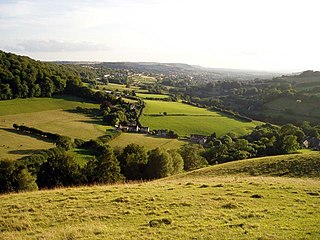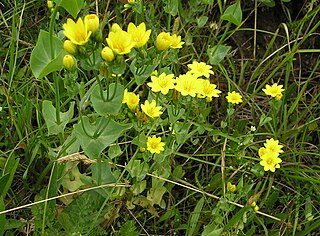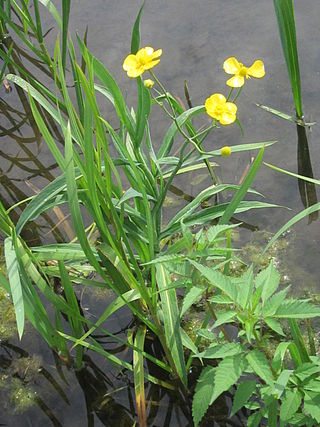
Ranunculus is a large genus of about 1700 to more than 1800 species of flowering plants in the family Ranunculaceae. Members of the genus are known as buttercups, spearworts and water crowfoots.

Pulsatilla vulgaris, the pasqueflower, is a species of flowering plant belonging to the buttercup family (Ranunculaceae), found locally on calcareous grassland in Europe, and widely cultivated in gardens. It was considered part of the genus Anemone, to which it is closely related. Several sources still list Anemone pulsatilla as the accepted name, with Pulsatilla vulgaris as a synonym.

Ranunculus acris is a species of flowering plant in the family Ranunculaceae, and is one of the more common buttercups across Europe and temperate Eurasia. Common names include meadow buttercup, tall buttercup, common buttercup and giant buttercup.

Badgeworth SSSI is a 3.08-hectare (7.6-acre) biological Site of Special Scientific Interest in Gloucestershire notified in 1954 and renotified in 1983. Part of this site is owned and managed by the Gloucestershire Wildlife Trust as a nature reserve.

Ranunculus longirostris, the longbeak buttercup, is an aquatic plant in the buttercup family.

Ranunculus auricomus, known as goldilocks buttercup or Greenland buttercup, is a perennial species of buttercup native to Eurasia. It is a calcicole typically found in moist woods and at the margins of woods. It is apomictic, and several hundred agamospecies have been recognised.

Wingletang Down is a Site of Special Scientific Interest (SSSI) on the southern side of the island of St Agnes in the Isles of Scilly, England, UK, which is noted for its biological characteristics. The site is managed by the Isles of Scilly Wildlife Trust and is within the Isles of Scilly Heritage Coast and the Isles of Scilly Area of Outstanding Natural Beauty. It is the only site in Great Britain and Ireland for the small fern, least adder's–tongue. As of 11 September 2009 the SSSI was considered to be in ″unconditional recovering″ condition because European gorse and bramble are at unacceptable levels.
Ranunculus allenii, commonly known as Allen's buttercup, is a flowering plant in the crowfoot or buttercup family, Ranunculaceae. Generally found in wetlands in northern latitudes, it bears yellow flowers in summer, which are pollinated by insects.

Wotton Hill is a hill on the edge of the Cotswold Hills in Gloucestershire, England, 0.5 miles (0.80 km) north of Wotton-under-Edge. The Cotswold Way passes over the hill.
Clarke's Pool Meadow is a 1.8-hectare (4.4-acre) biological Site of Special Scientific Interest in Gloucestershire, notified in 1997. It lies on the flat top of 'Old Hill' about half a mile south of Blakeney. The site consists of two fields which were purchased by the Gloucestershire Wildlife Trust in 1997. The site was designated an SSSI in the same year and it is one of the finest surviving traditional hay meadows in Gloucestershire.

Swift's Hill is a 9.15-hectare (22.6-acre) biological and geological Site of Special Scientific Interest in Gloucestershire, notified in 1966 and renotified in 1984.

Foxes Bridge Bog is a 5.3-hectare (13-acre) nature reserve in Gloucestershire. The site is owned by the Forestry Commission and is managed by the Gloucestershire Wildlife Trust in partnership with the Forestry Commission. The site is listed in the 'Forest of Dean Local Plan Review' as a Key Wildlife Site (KWS).
Ridley Bottom is a 1.1-hectare (2.7-acre) nature reserve in Gloucestershire. The site is listed in the 'Forest of Dean Local Plan Review' as a Key Wildlife Site (KWS).

Chedworth Nature Reserve is a 6-hectare (15-acre) nature reserve in Gloucestershire. The site is listed in the 'Cotswold District' Local Plan 2001-2011 as a Key Wildlife Site (KWS).

Snows Farm Nature Reserve is a 21.3-hectare (53-acre) nature reserve in Gloucestershire. The site is listed in the ‘Stroud District’ Local Plan, adopted November 2005, Appendix 6 as a Key Wildlife Site (KWS).

Ranunculus acaulis, in Australia and New Zealand called dune buttercup, sand buttercup or shore buttercup, is a yellow-flowered, small, fleshy herb, that grows in mats in damp places mostly near the sea. It occurs naturally in Australia, New Zealand, Chile and the Falklands. It flowers between August and April and sets seed from September till July.
Ron Ward's Meadow With Tadley Pastures is a site of Site of Special Scientific Interest (SSSI). It is based on the edge of Tadley in Hampshire, England. It is managed by the Hampshire and Isle of Wight Wildlife Trust.

Ranunculus lingua, the greater spearwort, great spearwort, tongue-leaved crowfoot, or water buttercup, is a plant species in the family Ranunculaceae native to temperate areas of Europe, Siberia and through to the western Himalayas. It is a semiaquatic plant that prefers to grow in about 40 cm (16 in) of water in a variety of wetland habitats. A cultivar called 'Grandiflorus', the large-flowered greater spearwort, has 6 cm flowers and is favored by gardeners.
Archibald Sim Montgomrey was a wholesale timber merchant, county councillor and magistrate and amateur plant collector in Britain and other parts of the world.














